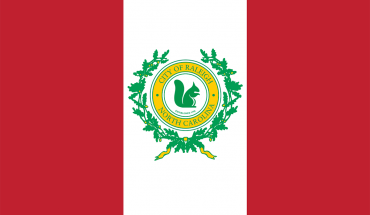
by Laura White
photographs by Eamon Queeney
Tucked in the back corner of a row of townhouse-style offices just off Six Forks Road is Triangle Radio Reading Service. In contrast to the sun-baked parking lot out front and the row of cars whizzing past just beyond, it is cool and quiet inside, and the back half of the building overlooks a lush scene of verdant trees and ivy-choked bushes.
The executive director, May Tran, greets visitors with a warm smile and a voice just above a whisper. Being soft-spoken is necessary, after all, when there is a live broadcast taking place just down the hall.
For 35 years, TRRS has been connecting the blind and print-impaired to the Raleigh community by delivering free local and national news and entertainment, as well as original content, via live broadcast and recorded audio. What began as an hour-long program in 1983 has grown to programming around the clock, with live readings taking place amidst scheduled shows and podcasts.
On a recent afternoon, the metered and melodic voice of a woman reading from the live studio trickles faintly down the hall; the feed from the control room echoes her. This is the nonprofit’s normal day-to-day scene.
During three live shifts per weekday plus one on Saturday and Sunday, TRRS reads The News & Observer, Indy Week, Cary Citizen, and other local papers, including those farther east, such as the Kinston Free Press. It also broadcasts readings of magazines like Our State, The New Yorker, TIME, Smithsonian, and Vanity Fair.

TRRS loans specialty tuned Subsidiary Communications Authorization receivers, or SCA radios, for picking up the station’s signal, which is broadcast on a subchannel of WUNC. Most FM radio broadcasts are restricted to 15 kHz; the human ear generally hears between 20 Hz to 20 kHz. The most common frequency for SCA broadcasts is 67 kHz, which tends to have more clarity and less interference than the other frequency, which is 92 kHz. TRRS can also be found on community access channel 22 in Raleigh, cable FM, and via web streaming. (Or, if you own an Amazon Echo, you can simply say “Alexa, play Triangle Radio Reading Service.”)
With a small staff of six people—only one of whom is full-time—and more than 150 volunteers, it’s no secret the driving force behind TRRS’ long-term success: that critical mass of 150. “It is kind of like a family here,” Tran says. “We have volunteers who have been reading with us over 25 years. We have volunteers who come in, people who love to read, and that’s one way to give back to the blind and print-impaired community.”
Volunteers are the lifeblood of TRRS, and those who join the team tend to stick around. One volunteer, Bob Kruger, is 95 years old and has been with TRRS for 30 years. Tran gestures to a wall full of calendars laid out in a three-month spread with handwritten names of volunteers penciled in for their reading times. Bright orange stickers pepper the pages, each one denoting that a program will need a substitute reader that day. This means volunteers who have been trained and waiting for their chance on air might finally get an opportunity.
TRRS’ development production and volunteer associate Sha Hargett Hill worked as a volunteer from 2012 to 2014 before moving to Florida briefly. She missed the station so much that she came back; she’s been a part-time employee since 2016. Tran herself has been on staff 18 years. “They can’t get rid of me!” she laughs.
While volunteers might be the driving force behind TRRS, diverse programming is what drives Tran. She wants to ensure that TRRS’ offerings encompass the wide range of its audience demographic, from local and national magazines to children’s story time to poetry and science fiction. In 2015, TRRS was honored for its non-reading entertainment by the International Association of Audio Information Services for Symphony Notes, a program reading the N.C. Symphony program notes for the season’s performances. There’s also a reading of the Spanish-language newspaper Qué Pasa Noticias every Saturday, which is one of the most popular broadcasts.

TRRS supplements with outside programming to suit audience interest, such as an exercise program based out of Arizona. It’s another one of the most popular programs. “From the outside, you think, oh this is a reading service,” Tran says. “Until you come in here—we do so much more.”
TRRS collaborates with the North Carolina Library for the Blind, the Governor Morehead School, and the North Carolina Department of Social Services for the Blind. Thanks to volunteers, the station even has a system to translate the program guide and the schedule into Braille for those who request it, Tran says, “One of our volunteers purchased the Braille paper and we (keep) it at the Governor Morehead School.”
The Governor Morehead School connection has also spurred the TRRS program called T3, short for “Teens, Tools, Talent,” which teaches blind students how to operate the audio equipment for course credit. One of the youngest volunteers, at 21, was actually a graduate of this program, and continued to work the soundboard until he got a full-time job.

On the other end of the audience, TRRS works with senior living facilities to rent out the SCA radios. “For a minimal one-time fee, these places can stream our radio station live to all their residents,” says Janet Schanzenbach, director of community relations. “Residents can listen to us 24/7.”
Fundraising is what fuels these possibilities. With no funding from the state or federal government, most TRRS funding comes from private donors, corporations, and individuals. This year, one of the fundraising priorities is to replace the 18-year old studio equipment. The TRRS audio system failed last December, so the organization hopes to raise $30,000 by October to replace and upgrade the technology. Until then, dedicated volunteers stepped up, creating a temporary solution so the show can go on. That dedication is what seems to create the family Tran is so proud of. She can name the volunteers off the top of her head, along with how they came to join TRRS, their roles and programs, and the amount of time they’ve been on board. “When I came here everybody was kind of young, but … you grow old together.”
Tune into TRRS to hear writer Laura White read a few Walter stories, including this one. You can find the broadcast schedule at trianglereadingservice.org.



